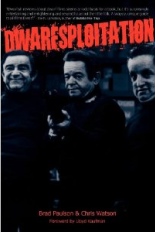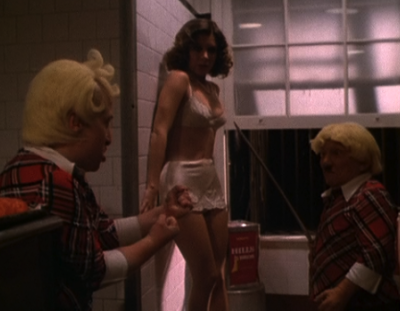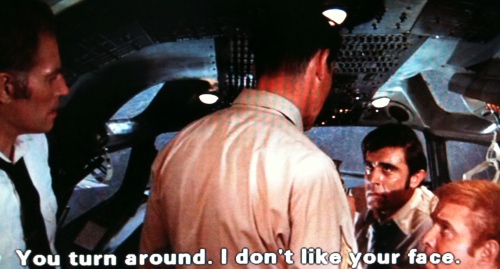Can you guess what movie or TV show we’re watching? We’ve turned on subtitles (when available) not to give you a clue, but to enhance that WTF effect! Leave your best guess in the comments to prove your true Flick Attackosity!

Can you guess what movie or TV show we’re watching? We’ve turned on subtitles (when available) not to give you a clue, but to enhance that WTF effect! Leave your best guess in the comments to prove your true Flick Attackosity!

Can you guess what movie or TV show we’re watching? We’ve turned on subtitles (when available) not to give you a clue, but to enhance that WTF effect! Leave your best guess in the comments to prove your true Flick Attackosity!

Can you guess what movie or TV show we’re watching? We’ve turned on subtitles (when available) not to give you a clue, but to enhance that WTF effect! Leave your best guess in the comments to prove your true Flick Attackosity!


 Immediately upon learning that Dwarfsploitation was, indeed, truly a book all about movies featuring midgets — pardon me, I mean “little people” — I thought that it had better discuss the seminal scene of Billy Barty cutting off Carrie Fisher’s dress with a sword in Under the Rainbow, or the guide wouldn’t be worth a pint of anything.
Immediately upon learning that Dwarfsploitation was, indeed, truly a book all about movies featuring midgets — pardon me, I mean “little people” — I thought that it had better discuss the seminal scene of Billy Barty cutting off Carrie Fisher’s dress with a sword in Under the Rainbow, or the guide wouldn’t be worth a pint of anything.
As they said in those spaghetti sauce commercials of the ’80s, it’s in there. Co-authors Brad Paulson and Chris Watson, both regular-sized humans, have compiled reviews on quite a wide selection of films. I didn’t count how many, but there are 320 pages’ worth, from The Adventures of Baron Munchausen to The Wonderful World of the Brothers Grimm, with more Weng Weng titles than I’ve been able to locate in between.
2010’s excellent Destroy All Movies!!! book rounded up every appearance of punks on film its writers could find — no matter the size of the role — and critiqued the flicks, hilariously. Paulson and Watson do the same here, but subbing dwarfs for punks, and not matching the wit of Destroy editors Zack Carlson and Bryan Connolly.
The passion for their subject is equal, however. In fact, Paulson and Watson even have created a handful of terms they use throughout, such as calling anyone who’s not a little person a “tallie.” That particular one is used the most, and kind of annoying after its first use.
Also, speaking of passion, either Paulson or Watson really, really wants to bang a female dwarf. The reviews are not credited, so I’m unsure exactly who has the hots for the little ones — maybe both. This assumption is drawn from the entries on the likes of Total Recall and I Hope They Serve Beer in Hell. It could be all an act, yet it’s not written like one.
 You’re not going to get deep insight into the films featured. That’s not the point. The point is celebrating the little guy, in an easygoing manner that’s both affectionate and amusing. For example, take this sentence from their look at Ghoulies 2: “The great dwarf actor Phil Fondacaro … looks like John Oates from the band Hall and Oates and wears suspenders.”
You’re not going to get deep insight into the films featured. That’s not the point. The point is celebrating the little guy, in an easygoing manner that’s both affectionate and amusing. For example, take this sentence from their look at Ghoulies 2: “The great dwarf actor Phil Fondacaro … looks like John Oates from the band Hall and Oates and wears suspenders.”
Without a doubt, unless you are stick-up-the-ass politically correct, Dwarfsploitation makes for a fun read. It is not without its, er, shortcomings — namely, it’s in desperate need of an editor. Whether repeatedly misspelling the name of someone as iconic as Diane Arbus or writing that Gremlins hit theaters in 2004, Paulson and Watson have turned in not the cleanest of copy. That loose nature may be appropriate for a project that sounds like it could’ve originated from a frat chat, but the errors number so many that I could not ignore them; I would be doing a disservice to potential readers if I chose not to bring it up.
Most people may gloss over that, instead to grow apoplectic that movies they expected to be covered are not. Now, Dwarfsploitation never claims to be complete, but for including as many obscure flicks as they have, notable omissions abound.
For example, where is Don’t Look Now? Scrooged? The Garbage Pail Kids Movie? Mulholland Dr.? On the Right Track? Jimmy the Kid? Burial Ground: Nights of Terror? The Sinful Dwarf? The Jackass franchise?
Actually, I’ll tell you where The Sinful Dwarf is: misfiled in the Ts. Again, a professional sweep-through could have elevated this book from recommended with reservations to highly recommended. —Rod Lott
Can you guess what movie or TV show we’re watching? We’ve turned on subtitles (when available) not to give you a clue, but to enhance that WTF effect! Leave your best guess in the comments to prove your true Flick Attackosity!
